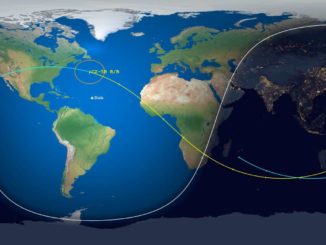
Three robotic Mars missions launched from Earth last month have begun fine-tuning their trajectories through the solar system with the first in a series mid-course corrections to take aim on the Red Planet for arrival next February.
NASA’s Mars 2020 Perseverance rover launched from Cape Canaveral on July 30, following successful launchings with the United Arab Emirates’ Hope orbiter July 19 and China’s Tianwen 1 Mars mission July 23.
The missions launched during a period of several weeks when Earth and Mars were in the right positions in their orbits around the sun to permit a direct route between the planets. All three spacecraft are due to arrive at Mars in February 2021.
NASA said Aug. 14 that the Mars 2020 mission’s first trajectory correction maneuver, or TCM, was a success. The spacecraft fired eight thrusters to adjust its course toward Mars, beginning to shift the probe’s initial post-launch aim point on to the Red Planet.
The mission’s Atlas 5 launcher intentionally released the Mars 2020 spacecraft on a course that would miss Mars, ensuring the rocket’s upper stage would not crash into the Red Planet.
As of Wednesday, the Perseverance rover cocooned inside the Mars 2020 spacecraft’s aeroshell had logged more than 35 million miles, or 56 million kilometers, since blasting off from Florida’s Space Coast on July 30.
Mars 2020 mission planners have set aside time and propellant for five trajectory correction maneuvers to refine the spacecraft’s path toward Mars and set up the rover to target a precise landing at Jezero Crater, an impact basin that once harbored a lake of liquid water with a river flowing into it.
The nuclear-powered Perseverance rover will explore the crater, seeking signs of ancient life while collecting rock core samples for return to Earth by a future mission.
In addition to the five planned course correction burns, Mars 2020 mission managers have opportunities to command the spacecraft to perform backup or contingency maneuvers if required.
The next trajectory correction burns for Mars 2020 are scheduled for Sept. 30, Dec. 18, Feb. 10, and Feb. 16. That will set the stage for the Perseverance rover’s landing on Mars on Feb. 18.

China’s Tianwen 1 mission completed its first post-launch course correction Aug. 1 (GMT), according to the state-run Chinese Xinhua news agency.
The spacecraft fired its main engine for 20 seconds in the first of several maneuvers planned during the trip to Mars. The maneuver also served as a test of the probe’s main engine, which performed well during the burn, Chinese officials said.
Tianwen 1 launched July 23 aboard a heavy-lift Long March 5 rocket. The ambitious mission will become China’s first to reach Mars, and includes an orbiter, lander and rover.
The spacecraft is scheduled to swing into orbit around Mars in February — using a lengthy engine burn — and the orbiter will survey candidate landing sites for two-to-three months before releasing the lander and rover to enter the Martian atmosphere.
If China pulls off those feats according to plan, they will make China the third country to perform a soft landing on Mars — after the Soviet Union and the United States — and the second country to drive a robotic rover on the Red Planet.
NASA has landed the only successful rovers on Mars to date.
The UAE’s Hope Mars orbiter has also successfully executed its first interplanetary course correction maneuver, mission officials announced Aug. 17.
In a tweet, officials described the event as a “major milestone” on the journey to Mars. It was the first firing of the probe’s six largest thrusters since the orbiter’s launch July 19 on top of a Japanese H-2A rocket.

Like NASA’s Mars 2020 mission and China’s Tianwen 1 spacecraft, the UAE’s Hope orbiter will arrive at Mars in February.
Funded and led by the United Arab Emirates — and developed in partnership with U.S. scientists — the Hope Mars probe carries a digital camera to image the Martian surface, dust storms and ice clouds, and spectrometers to measure constituents at multiple levels of the planet’s atmosphere.
The Hope mission is the Arab world’s first interplanetary probe.
Email the author.
Follow Stephen Clark on Twitter: @StephenClark1.



